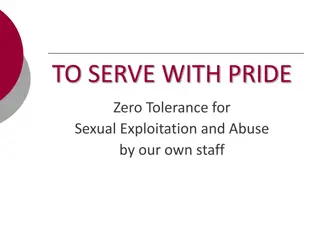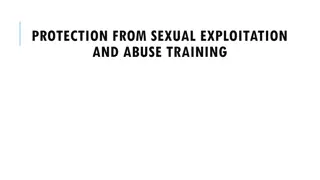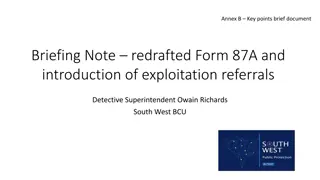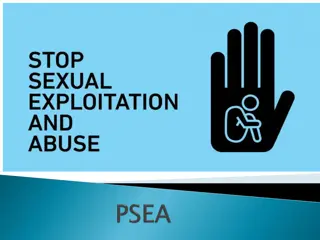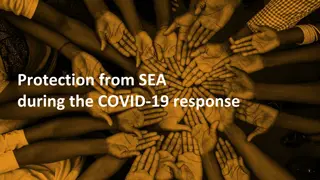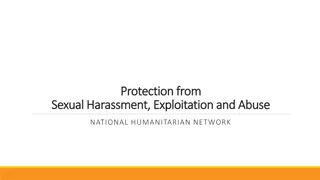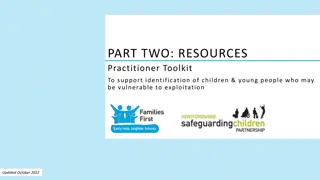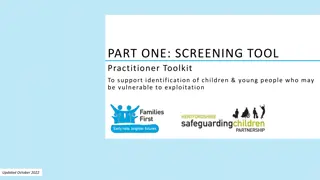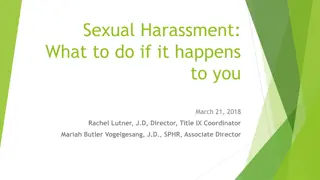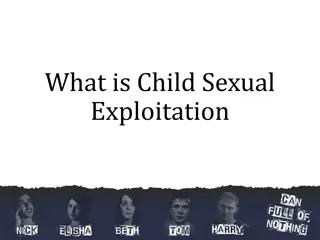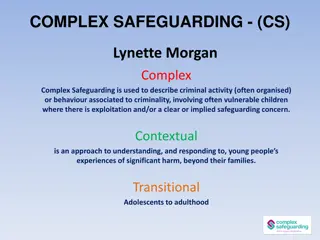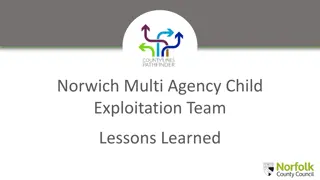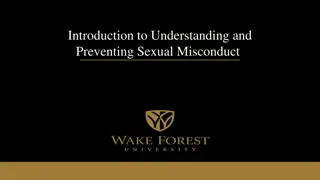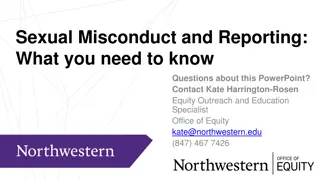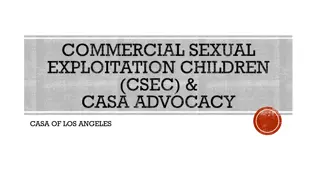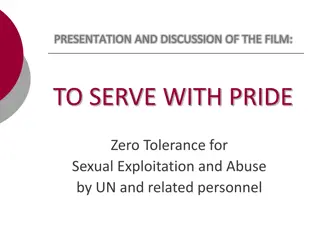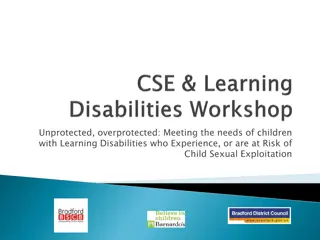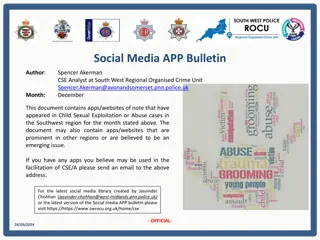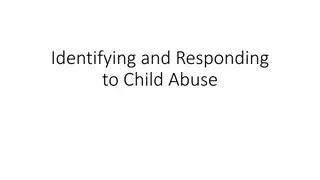Understanding Child Sexual Exploitation (CSE) in School Communities
Child Sexual Exploitation (CSE) is a form of child sexual abuse involving coercion, manipulation, or deceit for sexual activity. Vulnerable groups include children with disabilities, care leavers, those experiencing bullying, and more. Offenders employ grooming tactics to prepare victims and maintain control. Various types of CSE include peer exploitation, online exploitation, and organized trafficking.
Download Presentation

Please find below an Image/Link to download the presentation.
The content on the website is provided AS IS for your information and personal use only. It may not be sold, licensed, or shared on other websites without obtaining consent from the author. Download presentation by click this link. If you encounter any issues during the download, it is possible that the publisher has removed the file from their server.
E N D
Presentation Transcript
Child Sexual Exploitation (CSE): Briefing for the School Community
What is CSE? Child Sexual Exploitation (CSE) is a form of child sexual abuse. It occurs where an individual or group takes advantage of an imbalance of power to coerce, manipulate or deceive a child or young person under the age of 18 into sexual activity (a) in exchange for something the victim needs or wants, and/or (b) for the financial advantage or increased status of the perpetrator or facilitator. The victim may have been sexually exploited even if the sexual activity appears consensual. CSE does not always involve physical contact; it can also occur through the use of technology. (CSE Definition & Guidance Department for Education, February 2017)
Child Sexual Exploitation (CSE) What makes some children and young people more vulnerable of this type of abuse than others? Children with Disabilities/Special Educational Needs Care leavers/Looked After Children (LAC) Those experiencing bullying Children who go missing from home or care Those misusing alcohol and/or drugs Homelessness and poverty Parenting capacity issues, including DV, parental mental health Those with attachment issues School non-attendance Mental health disorders including depression Those known to existing victims e.g. siblings, friends Those with a poor understanding of sexual relationships History of abuse e.g. familial child sexual abuse, risk of forced marriage/honour-based violence Young offenders Being a young carer Lacking friends from the same age group Refugee or asylum seeker Trafficked child
Child Sexual Exploitation (CSE) Offenders and their behaviour: What is grooming ? A process by which an offender/perpetrator prepares a child and/or the environment for subsequent abuse. This will include gaining access to the child s compliance and maintaining the child s secrecy to avoid disclosure. There are six stages in the process targeting the victim, initially watching and then selecting; gaining the victim s trust; fulfilling a need; isolating the child from peers and family creating vulnerability and dependence; sexualising the relationship; maintaining control. Grooming can take place face-to-face, on the phone or on-line via social networking. It can take place over varying lengths of time from days to months. Offenders are likely to be grooming more than one young person at a time, potentially at different stages. The NSPCC provide comprehensive information on grooming
Types of CSE Peer on peer exploitation Relationship model On-line CSE Youth produced sexual imagery identified in schools Gangs and groups County lines Organised/networked sexual exploitation or trafficking Familial Opportunistic
Child Sexual Exploitation (CSE) Impact on individuals and families of CSE: Subtle but destructive crime that can impact on every part of a victims health, well- being and development. In particular, victims are at risk of sexual assault, rape, other violence, sexually transmitted infections, unwanted pregnancy, lack of educational progress, mental health issues. Behavioural changes put families under stress can lead to limited capacity to respond. Children/young people are encouraged to distance themselves from their families. Siblings put at risk of sexual exploitation. Offenders may be threatening/aggressive towards family members. Parents can feel frustrated and helpless when law enforcement and/or social care cannot stop the exploitation. Complete relationship breakdown. Child/young person becoming looked after. At risk of further exploitation and harm.
Child Sexual Exploitation (CSE) Indicators that a child or young person is being sexually exploited or is at risk of being. Physical symptoms including change in appearance, sexually transmitted infections (STIs), bruising, pregnancy, change in dress code. Mental health symptoms including, low self-esteem, self-harming, eating disorders, self-neglect, bed-wetting, fear of the dark. Changes in behaviour/character, including aggression, secretive, lying, no behavioural barriers, being withdrawn, moody, risk taking, promiscuity/sexualised behaviour/talk, loss of interest in usual activities/interests. Change in school/college attendance and fall in educational attainment. Episodes of being missing from home, staying out late, arriving late and visiting high-risk areas or addresses of concern. Presence of unexplained gifts including luxury items e.g. money, new clothes, mobile phones. Misuse of drugs and alcohol or increase in this. Trust issues with adults. New/second mobile phone, Increase in receipt of text messages , phone calls and time spent on the Internet/Social Media. Change in friendship group - older friend(s) Hearsay/rumours from other young people. Sudden interest in a particular religion/faith.
Child Sexual Exploitation (CSE) Prevention and protection of children and young people at risk: Ensure that the workforce and parents understand why is usual adolescent behaviour and what is a-typical. Identify those that are vulnerable and develop strategies to reduce risk, including supporting attachment. Education promotion of positive sexual relationships with young people what is healthy and what is unhealthy . Develop listening relationships with children and young people believe what you are being told. If you receive a disclosure, carefully note down exactly what the child/young person has said and refer on. Foster positive information sharing and seek advice/support early. Be aware of services that support children that go missing/runaway.
Child Sexual Exploitation (CSE) Myth Vs. Reality Myth - There are very few models of CSE. Myth It only happens in certain ethnic/cultural communities. Myth It only happens to children in care. Myth It only happens to girls and young women. Myth It is only perpetrated by men. Myth Perpetrators are always much older than their victims. Myth It only happens in large cities and towns. Myth Resilience is the same as coping.
Child Sexual Exploitation (CSE) The Redbridge Context The Multi Agency Sexual Exploitation (MASE) meeting takes place monthly and is led in line with the Pan-London Child Sexual Exploitation Operating Protocol (June 2017). Redbridge LSCB CSE Prevention and Intervention Strategy, 2ndEdition, 2018 Redbridge LSCB Missing from Care or Home Policy, 2ndEdition, 2017 and Missing Panel. Operation Make Safe police and community safety led-initiative with local businesses. Case work intervention/therapeutic work from Safer London Foundation, Barnardo's and Refuge. CSE Lead for LB Redbridge Cathy Worboyes, Head of CPAS and Early Intervention. CSE Co-ordinator for LB Redbridge Anna Watson, CPAS
Child Sexual Exploitation (CSE) Key points for learning: cascade key learning points with colleagues to raise awareness; raise awareness with parents/carers; be observant; recognise the signs; listen to what young people tell you; remember that they are a victim; clearly record and gather evidence; and refer to the Child Protection and Assessment Service (CPAS) using a Multi-Agency Referral Form (MARF).
Child Sexual Exploitation (CSE) Useful Resources: Working Together to Safeguard Children, 2015 Keeping Children Safe in Education, 2016 London Child Protection Procedures, 5thEdition, 2017 Worried about a child? LSCB Multi-Agency Threshold Document London CSE Operating Protocol, 3rdEdition, June 2017 LSCB Training Programme Introduction to CSE (1/2 day) and CSE for Practitioners (full day) LSCB eSafety and Peer-on-Peer Abuse Resource Directory


